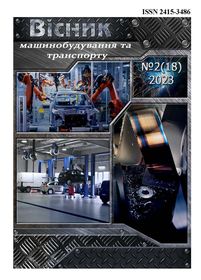Theoretical foundations of using three-link road trains for freight transportation
DOI:
https://doi.org/10.31649/2413-4503-2023-18-2-155-167Keywords:
three-link road train, freight transportation, controlled trailer link, overall traffic lane, maneuverability, power, torque differenceAbstract
Today, in the EU countries, three-link road trains of various layout schemes are used for freight transportation, in particular semi-trailer, trailer on a rolling cart and «B-Dauble» type, which helps increase the efficiency of the transportation process. The total weight of such road trains is the same and is at the level of 60 tons, and the length is up to 26 m. The satisfactory maneuverability of a three-link road train is expressed in the ability to fit it into all the turns found on the traffic routes and to maneuver (make turns and, if necessary, move reversing) at the loading and unloading points. Therefore, the comparative evaluation of the considered three-link road trains was carried out according to maneuverability.
Among the existing maneuverability indicators for road trains, the overall traffic lane (GSR) and the ability to move in reverse are the most important. The trajectories of the links of the road train, which determine the GSR, are obtained by solving the differential equations of motion for the road train of the «B-Double» type with all controlled axles, on the basis of which all other layout schemes are considered, during the circular motion of the road train. At the same time, it was established that only a three-link «B-double» type road train with a three-axle non-steerable first semi-trailer and a steerable second semi-trailer with a drive on its rear axle meets the requirements of Directive 2002/7/EC regarding maneuverability. Therefore, among the considered road trains, this type of road train may become promising. It has been established that the stable movement of the road train in reverse without assembling the links can be achieved by transferring the traction force to the rear steered axle of the semi-trailer. The necessary power of the engine installed on the rear axle of the semi-trailer was determined, provided the road train moves along a curved path, which was 65 kW. In the case of using the power method of turning the wheels of the rear axle of the semi-trailer, such engines must be located on each of the wheels. The necessary torque difference on the wheels of the axle of the semi-trailer, which corresponds to the angle of rotation of its steered wheels, is determined, under the condition of movement when moving along a curve of a given radius. Thus, at a fixed turning speed of v = 2 m/s when moving along curves of a small radius, the difference in torques on the axle of the semi-trailer should vary within 370–1050 Nm, which are provided by the adopted motor-wheels.
References
Поляков В. М., Сахно В. П. Триланкові автопоїзди. Маневреність. Луганськ: Ноулідж, 2014, 206 с.
DIRECTIVE 2002/7/EC of European parliament and of the council of 18 February 2002 amending Council Directive 96/53/EC of 25 July 1996 laying down for certain road vehicles circulating within the Community the maximum authorized dimensions in national and international traffic and the maximum authorized weights in international traffic. Official Journal of the European Communities. 2002. No L67/47-49. URL: https://www.legislation.gov.uk/eudr/1996/53/body
До порівняльної оцінки триланкових метробусів різних компонувальних схем за маневреністю / Сахно В. П. та ін. Сучасні технології в машинобудуванні та транспорті. 2020. № 1(14). С. 136–144. Doi: 10.36910/automash.v1i14.356.
Шарнірно-зчленовані автобуси. Маневреність та стійкість / В. П. Сахно та ін. Луцьк: ІВВ Луцького НТУ, 2021. 288 с.
Ingobert Schmid Engineering Approach to Truck and Tractor Train Stability. SAE Transactions. 1968, vol. 76, SECTION 1: Papers 670006–670125 (1968). Р. 1–26 (26 pages).
Колесникович А. Н., Выгонный А. Г. Устойчивость прицепного автопоезда повышенной длины (25,25 м) при прямолинейном движении. Актуальные вопросы машиноведения. 2018. Том 7. С. 96–100.
Yubiao, Khajepour Amir, Huang Yanjun. Multi-axle/articulated bus dynamics modeling: a reconfigurable approach. Vehicle System Dynamics International Journal of Vehicle Mechanics and Mobility. 2018. Vol. 56, issue 9. Р. 49–57.
Parallel Design Optimization of Multi-Trailer Articulated Heavy Vehicles with Active Safety Systems / Manjurul Md. Islam et al. Lecture Notes in Electrical Engineering 196:1563-1575. Ontario, Canada: University of Ontario Institute of Technology Oshawa, 2013. Doi:10.1007/978-3-642-33738-3_53.
Глінчук В. Вибір та обґрунтування типу та складу причіпних ланок триланкових автопоїздів руху: дис. … канд. техн. наук / Нац. ун-т водн. госп-ва та природокористування. Рівне, 2009.
До питання щодо динамічного способу управління автомобілем / Сахно В. П. та ін. Сучасні технології в машинобудуванні та транспорті. 2019. № 2(13). С. 156–164. Doi: https://doi.org/10.36910/automash.v2i13.98.
Downloads
-
PDF (Українська)
Downloads: 24



